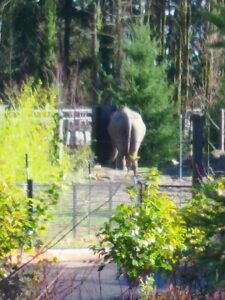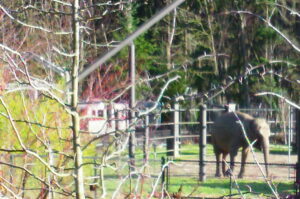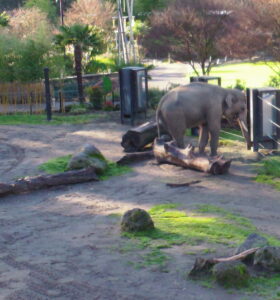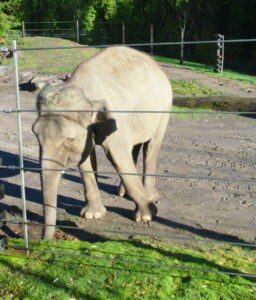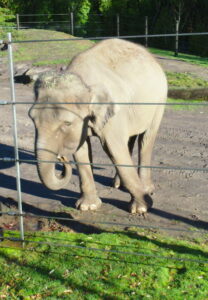Part 1
As we descended the trail, I sighted the hind end of an elephant, a cow, off to our left, not far away. She was feeding, as elephants usually are. We stopped to observe her, and snapped a couple photos. We started to head off down the trail, but then we realized that two other cows had joined her. Of course, they all were ladies in this small herd of Asian elephants. No bull, or bachelor, was nearby. When these females started to move away, so did we.
However, we rejoined them after turning north at the pond, and entering the meadow. These three ladies have been named: Chendra, Rose-Tu and Sung-Surin, also known as “Shine.” I wanted to know, who is considered to be the matriarch in this tiny herd? In a brilliant blue, clear sky, the sun shone with a gorgeous, full, mellow light, perfect for photography. On this last day of autumn, the temperature also was just right. In the meadow, we first encountered Rose-Tu, likewise eating. We were able to get quite close to her. The gland at her temple (the side of her head) was secreting its fluid. And she is pregnant, due around the beginning of next year, 2025. A previous child of hers, a boy named Samudra, was born in 2008. His father is Tusko.
One time, as a youngster, Samudra casually walked over to Tusko’s food, and began to eat. Towering over him, his father cocked his head and glanced down with one eye. He swung his trunk to one side, then swiftly swung it back again, thereby knocking little Samudra away from his food. Samudra tumbled across the ground, and eventually regained his composure in an upright position. His mother, Rose-Tu, was observing this ‘training moment,’ and she actually appeared to have a smile on her face. Samudra undoubtedly learned the lesson: not to mess with Dad’s food again. As a child, he also enjoyed running up to a wet, slick floor, and then sliding across it. Although still an official member of this small herd, Samudra is now a very big boy, a teenager, nearly 16 years old. So he is almost ready to leave the herd, and join the ranks of the bachelors. (In the meantime, Samudra is kept apart from the females.)
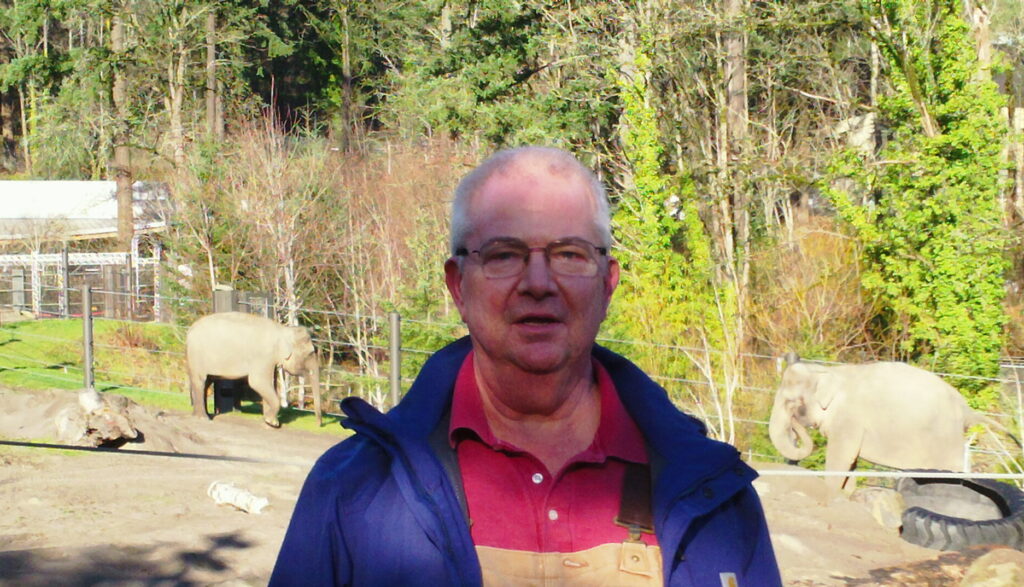
In the meadow, Sung-Surin, or Shine, joins Rose-Tu, and they feed together, standing side by side. I realize that Chendra remained behind, in the distant section of the meadow where we’d first observed her. Many years ago, Chendra’s arrival was heralded with much excitement and enthusiasm. She came from Sabah, Malaysia, where she was born in 1993. She is a Borneo pygmy elephant, which is a subspecies of Asian elephants. For this reason, Chendra is much smaller than the other two, weighing approximately 4,545-pounds. And she also has tusks, which appear as short, dull stubs because her caretakers keep them filed to a safe length. I walk to a viewpoint and have my picture taken with her in the background. Soon she begins walking in our direction. I record some video as she saunters along the trail, and before long she is very close to us. With her trunk, she begins to root in the dirt and grass beside the trail. This permits me to take some up-close photos of her. I wonder what she is finding as a result of this effort. Occasionally, she tosses some of the dirt onto her back.
One notable discovery we made that day was the title of an important book by Katy Payne: Silent Thunder: In the presence of elephants.
To be continued . . .

